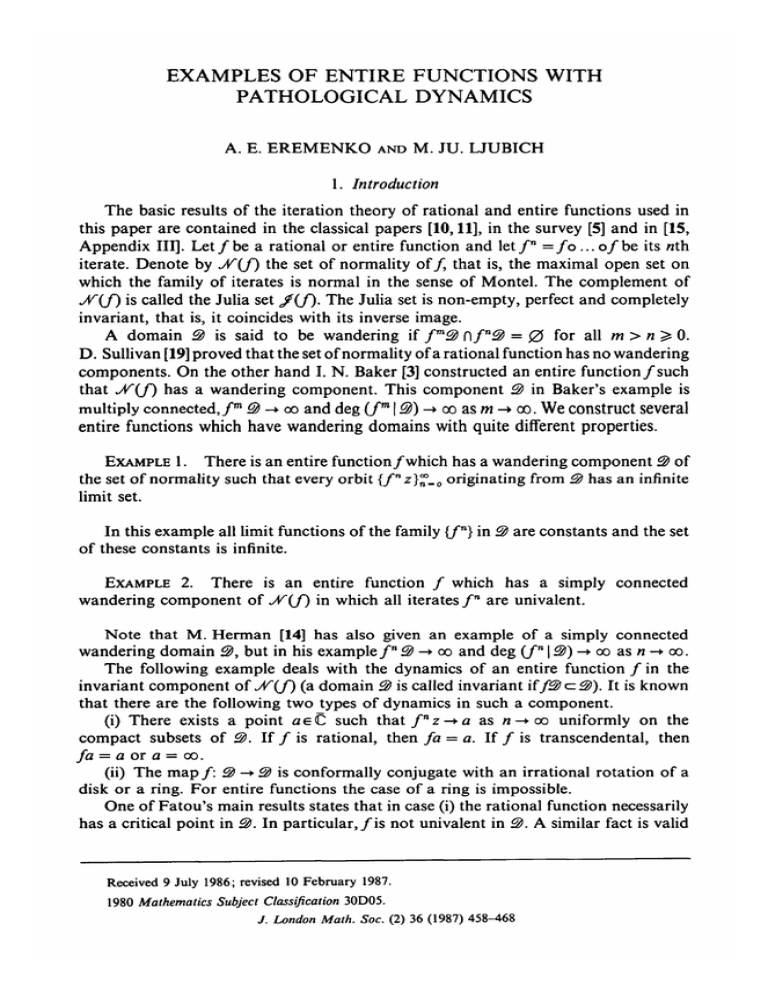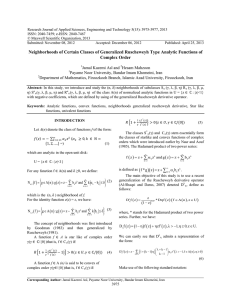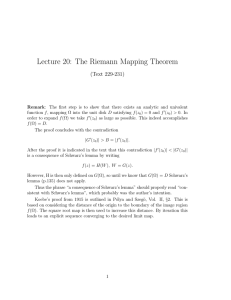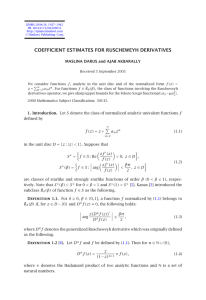examples of entire functions with pathological dynamics
advertisement

EXAMPLES OF ENTIRE FUNCTIONS WITH
PATHOLOGICAL DYNAMICS
A. E. EREMENKO AND M. JU. LJUBICH
1. Introduction
The basic results of the iteration theory of rational and entire functions used in
this paper are contained in the classical papers [10,11], in the survey [5] and in [15,
Appendix III]. Let / b e a rational or entire function and let/" = / o . . . o / b e its «th
iterate. Denote by Jf(f) the set of normality of/ that is, the maximal open set on
which the family of iterates is normal in the sense of Montel. The complement of
Jf(f) is called the Julia set </(/). The Julia set is non-empty, perfect and completely
invariant, that is, it coincides with its inverse image.
A domain Q) is said to be wandering if fmS) ()fn@ = 0 for all m > n ^ 0.
D. Sullivan [19] proved that the set of normality of a rational function has no wandering
components. On the other hand I. N. Baker [3] constructed an entire function/such
that ^V(f) has a wandering component. This component S> in Baker's example is
multiply connected,/"1 Q -> oo and deg (fm \ ®) -> oo as m -»oo. We construct several
entire functions which have wandering domains with quite different properties.
EXAMPLE 1. There is an entire function/which has a wandering component 3) of
the set of normality such that every orbit {/°z}™.0 originating from 3> has an infinite
limit set.
In this example all limit functions of the family {/"} in Q) are constants and the set
of these constants is infinite.
EXAMPLE 2. There is an entire function / which has a simply connected
wandering component of Jf(f) in which all iterates fn are univalent.
Note that M. Herman [14] has also given an example of a simply connected
wandering domain Q), but in his example/"2 -> oo and deg (/ n 12)) -> oo as n -> oo.
The following example deals with the dynamics of an entire function / in the
invariant component of Jf(f) (a domain 3 is called invariant iff2 c $j). It is known
that there are the following two types of dynamics in such a component.
(i) There exists a point aeC such t h a t / n z - > a as n-+co uniformly on the
compact subsets of Q). If / is rational, then fa — a. If / is transcendental, then
fa = a or a = oo.
(ii) The map / : Q) -> Q) is conformally conjugate with an irrational rotation of a
disk or a ring. For entire functions the case of a ring is impossible.
One of Fatou's main results states that in case (i) the rational function necessarily
has a critical point in S>. In particular,/is not univalent in 3). A similar fact is valid
Received 9 July 1986; revised 10 February 1987.
1980 Mathematics Subject Classification 30D05.
/. London Math. Soc. (2) 36 (1987) 458-468
EXAMPLES OF ENTIRE FUNCTIONS WITH PATHOLOGICAL DYNAMICS
459
n
for transcendental functions: if f z -*• a # oo in an invariant component S) of the set
of normality then / : 2) -*$> cannot be a covering map [2]. The following example
shows that this is not true in the case when a = oo.
EXAMPLE 3. There is an entire function/which has an invariant component Si
such that/"z -> oo as «-• oo, ze2) and/is univalent in 3.
Examples 1 to 3 are pathological from the point of view of the iteration theory of
rational functions. Let us note, however, that there exists a rather wide class S of
entire functions having dynamical properties similar to those of rational functions.
Define S to be the class of functions /such that there exists a finite set A, depending
o n / such that/: C\f~*A -* C\A is a non-ramified covering map. It was established
in [6,7] that a function fe S has no wandering components of Jf(f). We recently
learned that this result was independently obtained by L. Goldberg and L. Keen [13].
In [4] I. N. Baker proved the absence of wandering domains for a class of entire
functions which is contained in S. Every orbit in *V(J~), fe S, is bounded [6,7].
It is well known that the following alternative holds: the set Jf(f) is either dense
or empty. A natural question arises therefore: is it true that in thefirstcase the Julia
set </(/) n a s Lebesgue measure zero? An affirmative answer to this question for
rational/would lead to a description of the dynamics of a generic rational function.
For entire functions the answer is negative.
EXAMPLE 4. There is an entire function/such that the Julia set,/(/) is nowhere
dense but mes f(f) > 0.
In the theory of quasiconformal deformations and structural stability of analytic
dynamical systems [8,9,16,17,19] the following important question arises: does there
exist an invariant field of straight lines in ,/(/)? We show that such afielddoes exist
in Example 4. Slightly modifying this example we obtain the following.
EXAMPLE 5. There is an entire function/which has an infinite-dimensional family
of measurable invariant fields of straight lines in #(f).
The construction of our Examples 1 to 5 is based on the theory of approximation
by entire functions. The necessary results from this theory are contained in §2.
Examples 1 to 3 are constructed in §3 and Examples 4 and 5 are in §4. The results of
the paper were announced in [6], their detailed exposition in Russian was given in the
preprint [7].
2. Results on approximation by entire functions
We shall make use of the following classical result.
RUNGE'S THEOREM. Let K c= C be compact with connected complement. Then any
function analytic on K can be uniformly approximated by polynomials. (By a function
analytic on K we mean a function analytic in a neighbourhood of K.)
Using this theorem we prove a result on simultaneous approximation and
interpolation.
460
A. E. EREMENKO AND M. JU. LJUBICH
MAIN LEMMA.
Let {Gk}^_x be a sequence of compact subsets ofC with the following
properties:
(i) C\Gk is connected for every k;
(ii) GkOGm =
0fork*m;
(iii) min {|z\: ze (?*}-• oo.
Let zkeGk, ek > 0 and the function <j> be analytic onG = [Jk>l Gk. Then there exists
an entire function f satisfying
\f(z)-<f>(z)\<ek,
zeGk;
(1)
/(z,) = 0(zt), f'{zk) = <j>'{zk), keN.
(2)
The original proof of the main lemma due to the authors was considerably
simplified by Ju. I. Ljubich who suggested that we apply the following geometrical
statement.
LEMMA 1. Let Abe a locally convex linear topological space, let V be a domain in
A, let W be a convex dense subset in V and let S be an affine subspace of A of finite
codimension, such that SO V ^ 0. Then SO W is dense in SoV.
Proof. By induction on codimension the proof is reduced to the case of S having
real codimension 1. Then S is defined by the equation F(g) = %> where F is a
continuous linear functional. Let geVo S and let B be a convex neighbourhood of g.
Since W is dense in V, we can find flt f2e W0 B such that Ftf^ > <g, F{f2) < <$. Set
f=tf1 + (\-t)f2, where
We have/e W 0 B and F(J) = <€. Lemma 1 follows.
Proof of the main lemma. Let % be a simply connected neighbourhood of Gx such
that (j> is analytic in °ll and % 0 Gk = 0 for k ^ 2. Consider the space s/ of all
functions analytic in % with the topolgy of uniform convergence on compact sets.
Consider the convex domain in A:
V={g:\g(z)-<t>(z)\<\evzeG1}.
Let W be the subset of V consisting of polynomials. By Runge's theorem W is dense
in V. Clearly W is also convex. Now consider the affine subspace
S = {geA:g(Zl) = 0(2,), g\Zl) = 0'(*i)}.
By Lemma 1 there exists/ie WoS; that is,/i is a polynomial satisfying
EXAMPLES OF ENTIRE FUNCTIONS WITH PATHOLOGICAL DYNAMICS
461
By a similar argument we find a sequence of polynomials fm with the following
properties
m,
ek,
zeGm;
(3)
zeGk,k<m;
(4)
|z|<|min{|C|:CeGJ;
E /*(*«) = 0<*J.
I fM
*-i
fc-i
= t'M'
(5)
Ki<m.
(6)
It follows from (5) that the series/= Em-i/m converges uniformly on the compact
subsets of C and defines an entire function. Finally (3), (4) imply (1) and (6) implies
(2). The main lemma is proved.
Furthermore, we need two technical lemmas.
LEMMA 2. Let J{z) = z+g(z) be an analytic function in the disk {z: \z\ < R) such
that g(0) = g'(0) = 0 and \g(z) \<eRfor\z\<
R and some e<\. Then
|argy(z)-argz|<2-||z|,
\z\<R.
(8)
Proof. The function g(z)/z2 is analytic in {z:\z\ < R] and by the maximum
principle its modulus does not exceed e/R. This immediately implies (7). Furthermore,
| a r g y ( z ) - a r g z | ^ | log(/(z)/z)| = I log(l +g(z)/z)\ ^ 2\g(z)/z\
< 2 ^ \z\,
and (8) is also proved.
LEMMA
3. Let q > 1. Then there exists a number s(q) such that the estimates
m-l
r
o E e*< ^ ) »
ro>0,efc>0
*-o
and
r*0-£ k r k ) < rk+x ^ rk(\ +ekrk),
imply that
1
- ro < rk ^ 1 ro>
q
Proof
O^k^m-l
0 < k < m-
Let
m-l
/
i
-oE£*<-1°g^
Suppose inductively that rt ^ qr0, 0 ^ / ^ k— 1. Then we obtain
i-0
\<-0
By (9) the last expression does not exceed qr0.
(9)
462
A. E. EREMENKO AND M. JU. LJUBICH
Now choose y > 1 such that the estimate 1 — x ^ exp( — yx) holds for 0 < x < \.
Suppose that
r, | o «. < min { 1 log , , 1 } : = <«)•
We have already proved that under this condition the estimates rt<qr0,0
hold. Thus we have
^i^m
£ e, rt \> r0 exp - yr0 q ^
i-0
i-Q
I
\
i-0
Lemma 3 is proved.
3. Pathological dynamics on the set of normality
1. There is an entire function/having a wandering component Q) of the
set of normality such that every orbit {/nz}"_0 originating from S> has an infinite limit
set.
EXAMPLE
FIG.
1
Fix e, q such that 0 < e < f, 1 < q < 2% and consider a sequence {Rm}™_0 satisfying
0<Rm<1^Rm_1,
m-l
in = 1 , 2 , . . . ;
(10)
n
where 5 = s(#) is chosen by Lemma 3. Define a sequence {flm}^.0
^ m = {z: q~2Rm < | z| < ^r"1 Rm, | argz| < in},
Qm = (2:^" 3 ^ ro < | z - a j < ^ m , | a r g z | < |TT}
s u c n t n a t fl
o = 0,
EXAMPLES OF ENTIRE FUNCTIONS WITH PATHOLOGICAL DYNAMICS
463
(see Figure 1), and define the function 0 on the set (J*_o (Bm U Qm) in the following
way:
</>(z) = z + am+1-am,
z€Bm,meZ+;
<p(z) = q-*Rm+1,
zeQm,meZ+.
By the main lemma there exists an entire function / satisfying
A<*J = a«+i,
/K)=l
\J[z)-<f>(z)\<lERm,
rnel+;
(12)
zsBm,mGl+;
(13)
<= 3 ^ ,
meZ + .
(14)
We show that S>0 a jV(f) and the iterates / " DQ have constant limit functions am.
Let \z\ < \Rm, rk = \fkz-ak\, keZ+. We shall prove that
Q'1 ro^rk<
<lro> 0<k^m.
(15)
Suppose inductively that
q'1 ro^rt^
qr0,
0^i^k-\
< m.
As qr0 < (2*/2)Rm < Rm < iK,, it follows t h a t / z e ^ , 0 ^ / ^ k- 1. Then, from (12)
and (13) and Lemma 2, we have
By (11),
_
m-1
p
<-0 ^i
(-0
^i
m-l
Using Lemma 3 we obtain
<fX H^r^
qrQ.
Thus (15) is proved by induction, and we have
fkzeBk,
0^k^m-l.
Using Lemma 2 once more, we obtain
-flt)|^ 2e-^ ^ 2 £ ^ ,
0 ^ A: ^
m-l.
Therefore, by (11),
m-l
D
2 £
t-o
It follows from this and (15) (for k = m) t h a t / m 0 m c e m , meZ + . Since/g m c ®m+1,
by (14), it follows that a0 = 0 is a limit point for every orbit originating from ^ 0 .
Hence all points am have the same property. The required example is constructed.
PROBLEM. Does there exist an entire function/and a component 3) oiJ/~{f) such
that the limit functions of subsequences of/" in Q) form an infinite bounded set?
To construct Examples 2 and 3 we need the following approximation theorem (see
for example [12]).
464
A. E. EREMENKO AND M. JU. LJUBICH
ARAKELJAN'S THEOREM.
Let G c C be a closed set. The following properties are
equivalent :
(i) every function <j> continuous on G and analytic in the interior of G can be
uniformly approximated by entire functions ;
(ii) C\G is connected and locally connected at oo.
2. There is an entire function/having a simply connected wandering
component of JV(J) in which all iterates are univalent. Let us consider the following
vertical strips symmetric with respect to the lines {z: Rez = 3m}, m = 10,11,...:
EXAMPLE
nm = {z:|Rez-3m|<l},
l-2" m - 2 },
U'm = {z:\Rez-3m\<
I i ; = { z : | R e z - 3 m | < 1-2-"1}.
Let <j)m be a linear function which maps FI^ onto ITm+1. Obviously
|Re(0m(z)-3(m+l))-Re(z-3in)|<2-,
zeWm.
(16)
Now consider the strip
n* = {z:|Rez-30|<|}.
It follows from (16) that
0mO0m-l o -°01o n * c I 1 »+l»
m==
10,11,....
Using Arakeljan's theorem construct the function / satisfying
z68nra,m=10,ll,...;
(17)
zeU={z:|z|<l}.
The unit disk is invariant and hence it is contained in jV(f). Further, it is easy to
see that fmU* c n^ + 1 0 . Consequently n * is contained in JV(J). Let S> be the
component of Jf{f) containing II*. T h e n / m z -> oo in <2). However if ze9IT m then
by (17) the orbit {/mz}~_0 is bounded. Thus fmS) e n m + 1 0 and ® is a wandering
component.
Now we check that the iterates o f / a r e univalent in Q). Consider the strips
Sem = { z : | R e z - 3 w | < 1 -2-" 1 - 1 }.
It is easy to see that/j£? m => ITm+1 and hence that fm <2) a SCm+10. Let us show t h a t /
is univalent in S£m. The Cauchy formula for derivatives implies that
\g'(z)\<l
for zeSem. Consequently, i f ^ z ^ =J[z2); zltz2e&m,
then
and hence zx = z2. Thus univalence is proved.
To check that S) is simply connected we apply the following lemma (see [4,
Theorem 3.1, Corollary] or [7, Proposition 3]).
EXAMPLES OF ENTIRE FUNCTIONS WITH PATHOLOGICAL DYNAMICS
465
LEMMA 4.
Let f be an entire function bounded on a curve tending to oo. Then all the
components of Jf{f) are simply connected.
This lemma completes the investigation of Example 2.
EXAMPLE 3. There is an entire function/which has an invariant component Q) of
the set Jf{J) such that/ n z -> oo as w -> oo, ze$), and/is univalent in Q).
Let us consider the half-planes
P1 = {z:Rez>-4},
P2 = {z:Rez < - 5 } .
Define the functions fx{z) = 2z in Px and/ 2 (z) = exp z — 6 in P2. By Arakeljan's
theorem there exists an entire function / such that
\Az)-Mz)\<l
zeP0i= 1,2.
This implies that Re/(z) > Re z + £ for z e ^ 0 = {z: Re z > 1}. Hence all orbits in <^0
tend to oo. Furthermore we have
sup{[/(z) + 6|:zei>}<l.
Hence all orbits in P2 tend to an attractive fixed point. Thus <2>0 and P2 are contained
in different components of Jf{f). Let Si be the component of Jf{J) containing @0.
Consider the line J27 = {z: Rez = — 3} c Pv We have/J^7 c P2 and hence
Let us show that/is univalent in 21. Let f{z) = 2z+g(z). Then \g(z) \ < \ in each
disk of radius 1 centred at Z G ! Hence \g'(z)\ <\, ze£. If f{zx) =f(z2); zx, z2e£,
then
2\z1-z2\ =
\g(zl)-g(z2)\^\\z1-z2\,
which implies that zx = z2. Thus / is univalent in the half-plane 2. and, moreover,
in 2.
REMARK. M. Herman [15] gave an elementary example with the same properties
as those in Example 3.
4. Julia sets of positive area
EXAMPLE 4. There is an entire function/such that the Julia set,/(/) is nowhere
dense but mes /(f) > 0.
Consider a sequence ek > 0 such that
and the sequences of squares
Ql = {x + iy:\x-4k\
36 f; efc < 1,
fc
"°
< \+ek,\y\ < \+ek},
(18)
k = 0,\,....
Delete the following two strips from each Qk:
&k = {x + iy:x-4k\
< ek),
Mk = {x + iy: \y\ < ek}.
The set £?4\(i?fc U Jfk) is the union of four squares Qkp 1 ^y ^ 4. Consider the affine
surjective map </>kJ: QkJ -• Q\+1.
466
A. E. EREMENKO AND M. JU. LJUBICH
Using the main lemma (or Arakeljan's theorem) construct an entire function /
satisfying
(0 L/O)-0*.y(z)l<e*+i, zeQkJ;
(ii) / i s univalent in Qki and \f\z)\ > 2, zeQk};
(iii) / h a s an attractive fixed point a = — 2.
To verify condition (ii) we may apply the same reasoning as in Examples 2 and 3. It
follows from (iii) that f(J) is nowhere dense. We have
where
QM = {x + i>: |*-4(*+1)1 < \+2ek+l,\y\ < \+2ek+l}.
Consider the set
3-1
It is the union of 4 n+1 disjoint closed sets A^n)< t , 1 ^ ik ^ 4 on each of which/" is
n
<00>
univalent. Since diam K^l
= n»-o # B ) is a Cantor set.
t ^ 2" it follows that ^
00
bv E W e have mes E
We show that mesX* ' > 0. Denote £»\U?-i Qn,j
nn < 3 6 enn
n
n)
As | (J Y | > 2 , z £ ii^ , it follows that
qo">..i<n n / - " " 1 ^ , ) ^ 36eB+1-4-"-\
Hence mes(^ n) n / - " ' 1 ^ ^ ) ^ 36en+1. As ^ n + 1 ) = K{n)\rn~1 En+X, the required
statement follows from (18).
Furthermore if z e ^ 0 0 ' then |/ n (z) | = O(n), n -+ oo, and | (/n)'(^) I > 2n. Thus the
spherical derivative
) I2) - oo,
REMARK.
n -» oo
In Example 4 as constructed,
mes{z€,/(/):|/ m z| -> oo,m->oo} > 0.
Combining the ideas of this example and of Example 1 we may construct an entire
function / for which
mes{zG/(/): Hm |/ n z| < oo} > 0.
n-»oo
PROBLEM.
Construct an entire function / with the property that
mes {z e«/(/): sup \fnz | < oo} > 0.
n
EXAMPLE 5. There is an entire function/having an infinite-dimensional family of
measurable invariant fields of straight lines on </(/).
Given afieldof straight lines on a set X <= C, let 0(z) be the angle between the line
corresponding to zeX and the positive ray of the real axis. As 0(z) is defined only
modulo nz it is convenient to determine the field of lines by the function
MZJ
fexP2*0(z), zeX,
~\0,
zeC\X.
EXAMPLES OF ENTIRE FUNCTIONS WITH PATHOLOGICAL DYNAMICS
467
A field is called measurable if the function fi is measurable. Such a field is defined
almost everywhere and is considered as non-trivial if mesAr> 0. We mean that //
defines the field not only on X but on all sets 7 D I The field is called invariant
We show that in Example 4 there exists a non-trivial invariant field of lines on
/(J). Set ck = $'kJ (z) > 2, z e Qki. Let 3k > 0, £"_„ Sk < oo and the approximation of
(j>k} by/is so close that \f'(z) — ck\ < Sk, zeQky Then
| arg/'(z) | = | Im log {f\z))/ck) \ ^ A \f'(z)/ck -11 ^ A Sk,
zeQkj.
fc
Thus the series 6{z) = — £"_0 arg/'(/ z) converges absolutely and uniformly on the set
JS? = (Jn-o/"^ 00 ' anc* defines there a continuous function. Moreover,
and consequently 6 defines a non-trivial invariant field of lines on 5£'. This field has
the natural extension to an invariant field on the completely invariant set
To construct the entire function required in Example 5, one has to carry out the
construction of Example 4 simultaneously on an infinite set of sequences of squares.
One obtains infinitely many disjoint completely invariant sets if* having positive
measure. Moreover, there exists an invariant field of lines nk on each «£?*. These fields
generate an infinite-dimensional family of invariant fields £*_! Xknk, AfceC, \Xk\ = 1.
REMARK C. McMullen [18] proved that mes / ( / ) > 0 for/(z) = sin z. This Julia
set cannot carry an infinite-dimensional family of invariant fields of lines because
feS.
References
1. I. N. BAKER, 'Repulsive fixpoints of entire functions', Math. Z. 104 (1968) 252-256.
2. I. N. BAKER, 'Limit functions and sets of non-normality in iteration theory', Ann. Acad. Sci. Fenn.
(Ser. A 7)467(190) 1-11.
3. I. N. BAKER, 'An entire function which has wandering domains', J. Austral. Math. Soc. (Ser. A) 22
(1976) 173-176.
4. I. N. BAKER, 'Wandering domains in the iteration of entire functions', Proc. London Math. Soc. (3)
49 (1984) 563-576.
5. P. BLANCHARD, 'Complex analytic dynamics on the Riemann sphere', Bull. Amer. Math. Soc. 11
(1984)85-141.
6. A. E. EREMENKO and M. Ju. LJUBICH, 'Iterates of entire functions', Soviet Math. Dokl. 30 (1984)
592-594.
7. A. E. EREMENKO and M. Ju. LJUBICH, 'Iterates of entire functions', preprint, Physico-Technical
Institute of Low Temperatures Ukrain SSR Academy of Sciences, Kharkov, N 6 (1984) 1-37.
8. A. E. EREMENKO and M. Ju. LJUBICH, 'Structural stability in some families of entire functions',
preprint, Physico-Technical Institute of Low Temperatures Ukrain SSR Academy of Sciences,
Kharkov, N 29 (1984) 1-36.
9. A. E. EREMENKO and M. Ju. LJUBICH, 'Structural stability in some families of entire functions', Funkt.
Anal. Appl. 19 (1985) 86-87.
10. P. FATOU, 'Sur les equations fonctionnelles', Bull. Soc. Math. France 47 (1919) 161-271; 48 (1920)
33-94; 208-314.
11. P. FATOU, 'Sur l'iteration des fonctions transcendantes entieres', Ada Math. 47 (1926) 337-370.
12. D. GAIER, Vorlesungen u'ber Approximation im Komplexen (Birkhauser, Basel, 1980).
13. L. GOLDBERG and L. KEEN, 'A finiteness theorem for a dynamical class of entire functions', Ergod.
Theory Dynam. Systems 6 (1986) 183-192.
468
EXAMPLES OF ENTIRE FUNCTIONS WITH PATHOLOGICAL DYNAMICS
14. M. HERMAN, 'Exemples de fractions rationnelles ayant une orbite dense sur la sphere de Riemann',
Bull. Soc. Math. France 112 (1984) 93-142.
15. M. HERMAN, 'Are there critical points on the boundaries of singular domains?', Commun. Math. Phys.
99 (1985) 593-612.
16. M. Ju. LJUBICH, 'Some generic dynamical properties of rational mappings', Uspehi Mat. Nauk 38
(1983) 197-198.
17. R. MANE, P. SAD and D. SULLIVAN, 'On the dynamics of rational maps', Ann. Sci. Ecole Norm. Sup.
16 (1983) 193-217.
18. C. MCMULLEN, 'Area and Hausdorff dimension of Julia sets of entire functions', preprint, MSRI,
Berkeley, California, 1986, 1-15.
19. D. SULLIVAN, 'Iteration des fonctions analytiques complexes', C. R. Acad. Sci. 294 (1982) 301—
304.
Institute for Low Temperature Physics and Engineering
Academy of Sciences Ukrain SSR
47 Lenin Prospect
310164 Kharkov
USSR





